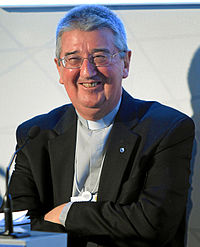Archbishop of Dublin (Roman Catholic)
| Archbishop of Dublin | |
|---|---|
| Bishopric | |
| catholic | |
 |
|
| Incumbent: Diarmuid Martin since 26 April 2004 |
|
| Style | His grace |
| Country | Republic of Ireland |
| Cathedral | St Mary's Pro-Cathedral |
| First incumbent | Dúnán |
| Formation | 1028 |
| Website | dublindiocese |
The Archbishop of Dublin (Irish: Ard-Easpag Bhaile Átha Cliath) is the title of the senior cleric who presides over the Archdiocese of Dublin. The Church of Ireland has a similar role, heading the United Dioceses of Dublin and Glendalough. In both cases, the Archbishop is also Primate of Ireland. The Archbishop has his seat at Saint Mary's Pro-Cathedral, though formally Dublin's cathedral is still Christchurch Cathedral, Dublin.
The Dublin area was Christian long before Dublin had a distinct diocese, and the remains and memory of monasteries famous before that time, at Finglas, Glasnevin, Glendalough, Kilnamanagh, Rathmichael, Swords, Tallaght, among others, are witness to the faith of earlier generations, and to a flourishing Church life in their time. Several of these functioned as "head churches" and the most powerful of all was Glendalough. In the early church in Ireland, the church had a monastic basis, with greatest power vested in the Abbots of the major communities. There were bishops but not organised dioceses in the modern sense, and the offices of abbot and bishop were often comprised in one person. Some early "Bishops of Dublin", back to 633, are mentioned in Ware's Antiquities of Ireland but the Diocese of Dublin is not considered to have begun until 1038, and when Ireland began to see organised dioceses, all of the current Diocese of Dublin, and more, was comprised in the Diocese of Glendalough.
Following a reverted conversion by one Norse King of Dublin, Sitric, his son Godfrey became Christian in 943, and the Kingdom of Dublin first sought to have a bishop of their own in the 11th century, under Sitric MacAulaf, who had been on pilgrimage to Rome. He sent his chosen candidate, Donat (or Donagh, Dúnán or Donatus) to be consecrated at Canterbury, England, in 1038, and the new prelate set up the Diocese of Dublin as a small territory within the walled city, over which he presided until 1074. Sitric also provided for the building of Christ Church Cathedral in 1038 "with the lands of Baldoyle, Raheny and Portrane for its maintenance."
...
Wikipedia
